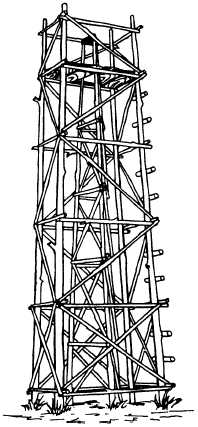Signals
Signals are those survey targets that either are
illuminated by natural sunlight or are electrically lighted
by use of wet or dry cell batteries. The observations for
all first- and second-order triangulation and first-order
traverse are usually done at night using signal lights,
because of more stable atmospheric conditions, which
allow for better pointings. Observations maybe made
during daylight hours using lights, but for high-accuracy
surveys, this is done only under extreme conditions.
Some examples of signals are signal lights (fig.
15-21), a target set (fig. 15-22), and a heliotrope (fig.
15-23). The target set is a precise lighting device that is
generally used for short traverse lines. The heliotrope is
a device that reflects the rays of the sun through a pair
of mirrors set over a point and toward an observer on
another station. When standard signals are not available,
expedient lights can be used. Examples of expedient
lights are the headlights of a vehicle, a masked lantern,
or a boxed light bulb.
Supports (Towers)
Towers must be built on some stations to raise the
lines of sight to clear obstructions or to lengthen the lines
Figure 15-24.-Pole tower.
Figure 15-25.—Aluminum or steel tower.
of sight to increase distances between stations of area
surveys. A tower consists of an instrument stand (inner
structure) and a platform to support the observer (outer
structure). Towers fall roughly into three classes:
prefabricated aluminum or steel, wooden, and expedient
towers. The towers are usually constructed by a separate
crew, whose size depends upon the type of tower being
built. The expedient tower is usually a tower or high
structure that is already in the area.
Two examples of towers are shown in figures 15-24
and 15-25.
TRIANGULATION PROCEDURES
A triangulation survey usually involves the
following steps:
1. Reconnaissance—meaning the selection of the
most feasible points for stations
2. Signal erection on these points
15-31




